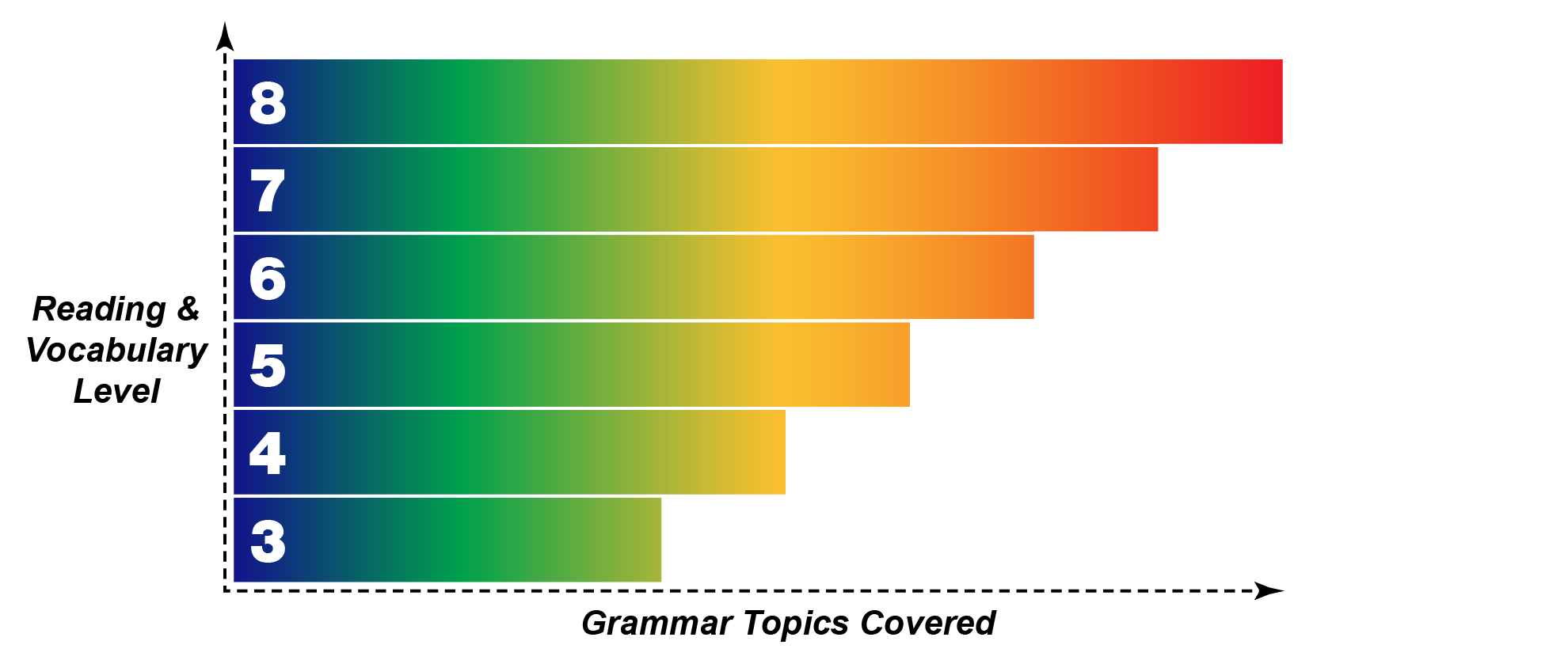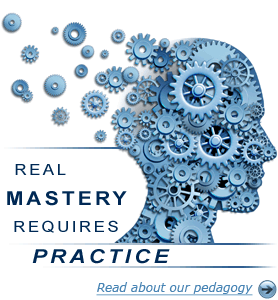Grammar and Writing FAQ
The following are questions commonly asked about the Grammar and Writing series. If you have a particular question that is not answered here, please contact us here.
You may also view sample lessons to review the structure of the program.
General Product Questions:
What is the Grammar and Writing program?
Grammar and Writing is a comprehensive English language arts curriculum designed to help students learn and remember the skills and concepts that will enable them to be successful communicators. The program is currently available for grades 3-8.
Which areas of language arts are covered?
The rigorous curriculum emphasizes English grammar, writing, vocabulary, punctuation, and spelling in context in the form of dictation. The hardcover Student Textbook includes the grammar and vocabulary components, while the softcover Student Workbook contains the writing lessons. See our Scope and Sequence [PDF].
Is a high school version available?
The program currently spans grades 3-8. However, high school students will benefit from Grammar and Writing 8, which thoroughly covers the skills needed for college-board exams.
In fact, co-author and college professor Christie Curtis has successfully used the content in Grammar and Writing 8 with her university English majors who exhibited remarkable improvement in their grammar skills.
Is Grammar & Writing the same as "Hake Grammar" and
"Saxon Grammar"?
A number of people refer to our Grammar and Writing program as "Hake Grammar" or "Saxon Grammar."
- Hake Publishing distributes the Grammar & Writing textbooks exclusively to schools using durable hardcover student textbooks for repeated classroom use. Schools must order directly from Hake Publishers. School orders »
- Saxon Homeschool distributes our Grammar & Writing textbooks exclusively to homeschool customers in single-use softcover form. Homeschoolers may order directly from Saxon or from other homeschool curriculum distributors. Homeschool orders »
The contents of the student materials for school and homeschool are nearly identical.
What materials are included in the Grammar and Writing series?
The materials include two components for students...
- Hardcover* Student Textbook (600+ pages) * Homeschool edition is softcover
- Softcover Student Workbook (120+ pages)
...and two components* for school teachers:
- Coil-Bound Teacher's Edition (replicates Student Textbook with answers in red)
- Loose-Leaf Teacher Packet with Tests, Supplemental Practice, and Answer Keys
Each grade level contains between 107-112 lessons to cover one school year. Online eBook access (for schools only) is also available as an optional add-on per Student Textbook.
*Note: The homeschool edition, published by Saxon, has a softcover student textbook and uses a single softcover answer key for parents (without the full Teacher Edition). Given the lesser durability and lighter teacher materials, the homeschool edition is not intended for use in school classrooms. Read more...
Is Grammar and Writing based on Common Core?
The Hake Publishing authors developed Grammar and Writing as a comprehensive language arts program long before the Common Core State Standards existed. Therefore, while the series is not based on Common Core, the rigorous and extensive content in Grammar and Writing already meets and exceeds the standards for English Language Arts in the areas of Language and Writing. For additional information, and to view correlations for each grade level, click here.
Questions on Our Methodology:
Why does the program emphasize grammar?
American education has gone through a phase during which it was assumed that children learned to read and write naturally, just as they learned how to talk. During this period, phonics nearly disappeared, writing was free-form, and grammar was given very little attention. It is now clear that reading and writing need to be taught and that students need to study and practice the conventions of English grammar. Students become better writers and speakers when they have a grasp of the mechanics of the English language. Students also find that a solid grounding in English grammar is a great benefit when learning another language.
What makes the program so effective?
The Grammar and Writing series is designed to make language arts easier to learn and harder to forget. Two unique features distinguish the series from other books: incremental development and continual review.
- Incremental development means that lessons on a topic are spaced over time, giving students the opportunity to master one step of instruction before attempting the next step.
- Continual review means that students practice everything they have been taught throughout the year. Every day is a review day that strengthens and reinforces their grammar and writing skills.
These proven techniques give students time to grasp a concept deeply and to move the learning from short-term to long-term memory. Further, students begin recognizing the interconnectedness of concepts instead of viewing skills in isolation.
Why does the table of contents look disorganized?
Grammar and Writing is not disorganized, it is differently-organized. Most textbooks are organized for easy reference by grouping lessons on topics such as punctuation, capitalization, and parts of speech, into chapters. This arrangement is not the most effective organization for learning. Grammar and Writing is organized to assist learning. When lessons on a topic are spaced, students have more time to learn each step of instruction before moving to the next.
As an aid to learning, Grammar and Writing weaves together the various topics of English grammar. We call this organizational approach incremental development. This approach also provides opportunity for continual review as students practice prior lessons in each daily review set.
We have placed small reference numbers in parentheses in the review sets below numbers of the exercises for students who want to refer back to the lesson where the topic was taught. We include a topical table of contents in the Teacher Packet for those who are interested.
Why are there no pictures in the book?
Compare a Grammar and Writing textbook with another publisher's textbook. The books have about the same number of pages. Which book has pictures? Which book has daily review sets? If there is not room for both, then which feature is more likely to contribute to long-term student success, pictures or daily review sets?
Thirty years of experience have shown that adding pictures to math textbooks does not augment student success, but adding pictures does increase the cost of the textbooks to schools. We have found that the same is true for language arts.
How is the Saxon method used in the Grammar & Writing program?
Stephen D. Hake, author of six textbooks in the Saxon® Math series, long desired to see a language arts curriculum employ the same proven methodology of incremental development and continual review that made his Saxon® Math books so effective.
Authors Christie Curtis and Mary Hake teamed up with Stephen to develop a rigorous and effective English language arts program that helps students learn and retain grammar concepts in their long-term memory using the same Saxon methodology that has worked so well for students across the country for over 30 years.
Questions from Teachers and Parents:
Do students need to start with the first book?
It is not necessary for older students to start at the lower levels, since prior-year topics are fully reviewed in the upper levels. The grade levels are differentiated by reading level, vocabulary difficulty, curriculum standards, and the overall pace and depth of instruction. No prior grammar instruction is required to begin at any grade level.
For best results, we recommend that students start at their comfortable reading level, but not higher than their current grade level, and complete a minimum of two years of the program. This will ensure that a strong foundation of language mastery endures, serving the students very well throughout higher education and adulthood.

Students beginning the curriculum in later grades will not miss any prior grammar content.
The reading level, subject depth, pace of instruction, coverage of additional topics,
and vocabulary difficulty increase with each level.
May I rearrange the order of the lessons?
The lessons should be taught in order without skipping lessons. The order of the lessons is carefully planned to provide students with enough time and practice to make steady progress through the program, and the content of the review sets reflects the order of the lessons. As you approach the time for state testing, if you feel that there are a few later lessons that students need to see prior to the test, then you might consider teaching those later lessons before the test.
How long does it take to complete one lesson?
Most students can complete both the lesson instruction and the review set in 30 to 50 minutes. We encourage teachers to offer abundant class time for students to work on the review set.
Where are the dictations and journal topics?
In Grammar and Writing 4 and up, you will find dictations and journal topics in the Appendix at the back of the student textbook. For Grammar and Writing 3 and below, dictations and journal topics are excluded. Instead, each lesson includes a "Grammar Meeting" component in which students practice forming grammatical sentences verbally.
May I shorten the review sets?
The review sets should be completed in their entirety. Daily review sets are not designed to be tests, but a learning tool which reinforces learning and helps the subject matter "stick" in a child's long-term memory. Shortening a review set reduces the practice students need to make the skills and concepts part of their long-term learning. Most students can complete a review set in 30 minutes or less, so the review sets should not be burdensome. Be sure to offer abundant class time for students to work on the review set.
How do I grade all the writing assignments?
There is no need to assign a letter grade to every writing assignment. Writing Lessons provide students tools to become better writers and to evaluate their own essays. A teacher can assess whether or not a student has correctly evaluated his or her completed essay and ask the student to edit and rewrite until the essay is satisfactory. Our goal is student success. Students’ writing will improve with practice. Some teachers allow students to submit two or three of their best essays during a grading period to receive letter grades. Journal entries are not meant to be graded.
What do students like about the program?
- Students enjoy success: A child's genuine success is often the best motivator of even greater efforts. Over 30 years of research and experience confirm that incremental development and continual review contribute greatly to student achievement.
- Students find the rich content interesting: Grade-appropriate Core Knowledge® content is embedded in the examples and exercises to reinforce learning in other subject areas. Students also enjoy the MadLibs®-style activities, the topical themes in each grade level, and the familiar characters that appear throughout the books.
Do you have a question that was not addressed here? Please contact us with your question. We look forward to hearing from you!

